Carbon Dot-Titanium Dioxide (CD/TiO2) Nanocomposites: Reusable Photocatalyst for Sustainable H2 Production via Photoreforming of Green Organic Compounds
Abstract
:1. Introduction
2. Materials and Methods
2.1. Materials
2.2. Synthesis of the CD/TiO2 Nanocomposites
2.3. Photoelectrodes
2.4. Characterization Methods
2.5. Photocatalytic Setup for Hydrogen Production and Detection
3. Results and Discussion
3.1. Photocatalyst Characterization
3.2. Photocatalytic Hydrogen Production with Ethanol and Glycerol Reforming
4. Conclusions
Supplementary Materials
Author Contributions
Funding
Institutional Review Board Statement
Informed Consent Statement
Data Availability Statement
Conflicts of Interest
References
- Li, Z.; Fang, S.; Sun, H.; Chung, R.J.; Fang, X.; He, J.H. Solar Hydrogen. Adv. Energy Mater. 2023, 13, 2203019. [Google Scholar] [CrossRef]
- Zoppi, G.; Pipitone, G.; Pirone, R.; Bensaid, S. Aqueous Phase Reforming Process for the Valorization of Wastewater Streams: Application to Different Industrial Scenarios. Catal. Today 2022, 387, 224–236. [Google Scholar] [CrossRef]
- Coronado, I.; Stekrova, M.; Reinikainen, M.; Simell, P.; Lefferts, L.; Lehtonen, J. A Review of Catalytic Aqueous-Phase Reforming of Oxygenated Hydrocarbons Derived from Biorefinery Water Fractions. Int. J. Hydrogen Energy 2016, 41, 11003–11032. [Google Scholar] [CrossRef]
- Pitchaimuthu, S.; Sridharan, K.; Nagarajan, S.; Ananthraj, S.; Robertson, P.; Kuehnel, M.F.; Irabien, Á.; Maroto-Valer, M. Solar Hydrogen Fuel Generation from Wastewater—Beyond Photoelectrochemical Water Splitting: A Perspective. Energies 2022, 15, 7399. [Google Scholar] [CrossRef]
- Nguyen, H.A.; Pham, T.N.; Le, N.T.T.; Huynh, L.T.N.; Nguyen, T.T.T.; Vo, Q.K.; Nguyen, T.H.; Le, V.H.; Nguyen, T.T.T.; Nguyen, T.T.; et al. Nanocomposite TiO2@CNTs for High-Voltage Symmetrical Supercapacitor in Neutral Aqueous Media. J. Solid State Electrochem. 2023, 27, 2811–2820. [Google Scholar] [CrossRef]
- Saleh, M.; Abdelhamid, H.N.; Fouad, D.M.; El-Bery, H.M. Enhancing Photocatalytic Water Splitting: Comparative Study of TiO2 Decorated Nanocrystals (Pt and Cu) Using Different Synthesis Methods. Fuel 2023, 354, 129248. [Google Scholar] [CrossRef]
- El-Bery, H.M.; Abdelhamid, H.N. Photocatalytic Hydrogen Generation via Water Splitting Using ZIF-67 Derived Co3O4@C/TiO2. J. Environ. Chem. Eng. 2021, 9, 105702. [Google Scholar] [CrossRef]
- Ren, Y.; Chen, Y.; Li, Q.; Li, H.; Bian, Z. Microwave-Assisted Photocatalytic Degradation of Organic Pollutants via CNTs/TiO2. Catalysts 2022, 12, 940. [Google Scholar] [CrossRef]
- Nguyen, H.P.; Cao, T.M.; Nguyen, T.T.; Van Pham, V. Improving Photocatalytic Oxidation of Semiconductor (TiO2, SnO2, ZnO)/CNTs for NOx Removal. J. Ind. Eng. Chem. 2023, 127, 321–330. [Google Scholar] [CrossRef]
- Kumaran, V.; Sudhagar, P.; Konga, A.K.; Ponniah, G. Photocatalytic Degradation of Synthetic Organic Reactive Dye Wastewater Using GO-TiO2 Nanocomposite. Polish J. Environ. Stud. 2020, 29, 1683–1690. [Google Scholar] [CrossRef]
- Rajoria, S.; Vashishtha, M.; Sangal, V.K. Electrochemical Treatment of Electroplating Wastewater Using Synthesized GO/TiO2 Nanotube Electrode. Environ. Sci. Pollut. Res. 2023, 30, 71226–71251. [Google Scholar] [CrossRef]
- Jagadeesh, B.S.; Muniyappa, M.; Navakoteswara Rao, V.; Mudike, R.; Shastri, M.; Tathagata, S.; Shivaramu, P.D.; Shankar, M.V.; Ananda Kumar, C.S.; Rangappa, D. Enhanced Photocatalytic Hydrogen Evolution from Reduced Graphene Oxide-Defect Rich TiO2−x Nanocomposites. Int. J. Hydrogen Energy 2022, 47, 40242–40253. [Google Scholar] [CrossRef]
- Liu, S.; Jiang, T.; Fan, M.; Tan, G.; Cui, S.; Shen, X. Nanostructure Rod-like TiO2-Reduced Graphene Oxide Composite Aerogels for Highly-Efficient Visible-Light Photocatalytic CO2 Reduction. J. Alloys Compd. 2021, 861, 158598. [Google Scholar] [CrossRef]
- Fei, Y.; Ye, X.; Al-Baldawy, A.S.; Wan, J.; Lan, J.; Zhao, J.; Wang, Z.; Qu, S.; Hong, R.; Guo, S.; et al. Enhanced Photocatalytic Performance of TiO2 Nanowires by Substituting Noble Metal Particles with Reduced Graphene Oxide. Curr. Appl. Phys. 2022, 44, 33–39. [Google Scholar] [CrossRef]
- John, D.; Jose, J.; Bhat, S.G.; Achari, V.S. Integration of Heterogeneous Photocatalysis and Persulfate Based Oxidation Using TiO2-Reduced Graphene Oxide for Water Decontamination and Disinfection. Heliyon 2021, 7, e07451. [Google Scholar] [CrossRef]
- Ibrahim, I.; Belessiotis, G.V.; Antoniadou, M.; Kaltzoglou, A.; Sakellis, E.; Katsaros, F.; Sygellou, L.; Arfanis, M.K.; Salama, T.M.; Falaras, P. Silver Decorated TiO2/g-C3N4 Bifunctional Nanocomposites for Photocatalytic Elimination of Water Pollutants under UV and Artificial Solar Light. Results Eng. 2022, 14, 100470. [Google Scholar] [CrossRef]
- Ratshiedana, R.; Kuvarega, A.T.; Mishra, A.K. Titanium Dioxide and Graphitic Carbon Nitride–Based Nanocomposites and Nanofibres for the Degradation of Organic Pollutants in Water: A Review. Environ. Sci. Pollut. Res. 2021, 28, 10357–10374. [Google Scholar] [CrossRef]
- Falara, P.P.; Ibrahim, I.; Zourou, A.; Sygellou, L.; Sanchez, D.E.; Romanos, G.E.; Givalou, L.; Antoniadou, M.; Arfanis, M.K.; Han, C.; et al. Bi-Functional Photocatalytic Heterostructures Combining Titania Thin Films with Carbon Quantum Dots (C-QDs/TiO2) for Effective Elimination of Water Pollutants. Environ. Sci. Pollut. Res. 2023, 30, 124976–124991. [Google Scholar] [CrossRef]
- Huang, X.; Sun, L.; Liu, X.; Ge, M.; Zhao, B.; Bai, Y.; Wang, Y.; Han, S.; Li, Y.; Han, Y.; et al. Increase and Enrichment of Active Electrons by Carbon Dots Induced to Improve TiO2 Photocatalytic Hydrogen Production Activity. Appl. Surf. Sci. 2023, 630, 157494. [Google Scholar] [CrossRef]
- Sendão, R.M.S.; Esteves da Silva, J.C.G.; Pinto da Silva, L. Photocatalytic Removal of Pharmaceutical Water Pollutants by TiO2—Carbon Dots Nanocomposites: A Review. Chemosphere 2022, 301, 134731. [Google Scholar] [CrossRef]
- Vyas, Y.; Chundawat, P.; Dharmendra, D.; Punjabi, P.B.; Ameta, C. Review on Hydrogen Production Photocatalytically Using Carbon Quantum Dots: Future Fuel. Int. J. Hydrogen Energy 2021, 46, 37208–37241. [Google Scholar] [CrossRef]
- Alsalka, Y.; Al-Madanat, O.; Curti, M.; Hakki, A.; Bahnemann, D.W. Photocatalytic H2 Evolution from Oxalic Acid: Effect of Cocatalysts and Carbon Dioxide Radical Anion on the Surface Charge Transfer Mechanisms. ACS Appl. Energy Mater. 2020, 3, 6678–6691. [Google Scholar] [CrossRef]
- Vitiello, G.; Clarizia, L.; Abdelraheem, W.; Esposito, S.; Bonelli, B.; Ditaranto, N.; Vergara, A.; Nadagouda, M.; Dionysiou, D.D.; Andreozzi, R.; et al. Near UV-Irradiation of CuOx-Impregnated TiO2 Providing Active Species for H2 Production Through Methanol Photoreforming. ChemCatChem 2019, 11, 4314–4326. [Google Scholar] [CrossRef]
- Tang, J.H.; Sun, Y. Visible-Light-Driven Organic Transformations Integrated with H2production on Semiconductors. Mater. Adv. 2020, 1, 2155–2162. [Google Scholar] [CrossRef]
- Wang, L.; Geng, X.; Zhang, L.; Liu, Z.; Wang, H.; Bian, Z. Effects of Various Alcohol Sacrificial Agents on Hydrogen Evolution Based on CoS2@SCN Nanomaterials and Its Mechanism. Chemosphere 2022, 286, 131558. [Google Scholar] [CrossRef]
- Pantoja-Espinoza, J.C.; Domínguez-Arvizu, J.L.; Jiménez-Miramontes, J.A.; Hernández-Majalca, B.C.; Meléndez-Zaragoza, M.J.; Salinas-Gutiérrez, J.M.; Herrera-Pérez, G.M.; Collins-Martínez, V.H.; López-Ortiz, A. Comparative Study of Zn2 Ti3 O8 and ZnTio3 Photocatalytic Properties for Hydrogen Production. Catalysts 2020, 10, 1372. [Google Scholar] [CrossRef]
- Muscetta, M.; Clarizia, L.; Garlisi, C.; Palmisano, G.; Marotta, R.; Andreozzi, R.; Di Somma, I. Hydrogen Production upon UV-Light Irradiation of Cu/TiO2 Photocatalyst in the Presence of Alkanol-Amines. Int. J. Hydrogen Energy 2020, 45, 26701–26715. [Google Scholar] [CrossRef]
- Toledo-Camacho, S.Y.; Rey, A.; Maldonado, M.I.; Llorca, J.; Contreras, S.; Medina, F. Photocatalytic Hydrogen Production from Water-Methanol and -Glycerol Mixtures Using Pd/TiO2(-WO3) Catalysts and Validation in a Solar Pilot Plant. Int. J. Hydrogen Energy 2021, 46, 36152–36166. [Google Scholar] [CrossRef]
- Alvarado-Ávila, M.I.; De Luca, S.; Edlund, U.; Ye, F.; Dutta, J. Cellulose as Sacrificial Agents for Enhanced Photoactivated Hydrogen Production. Sustain. Energy Fuels 2023, 7, 1981–1991. [Google Scholar] [CrossRef]
- Yao, Y.; Gao, X.; Li, Z.; Meng, X. Photocatalytic Reforming for Hydrogen Evolution: A Review. Catalysts 2020, 10, 335. [Google Scholar] [CrossRef]
- Yan, Z.; Yin, K.; Xu, M.; Fang, N.; Yu, W.; Chu, Y.; Shu, S. Photocatalysis for Synergistic Water Remediation and H2 Production: A Review. Chem. Eng. J. 2023, 472, 145066. [Google Scholar] [CrossRef]
- Lianos, P.; Strataki, N.; Antoniadou, M. Photocatalytic and Photoelectrochemical Hydrogen Production by Photodegradation Of organic Substances. Pure Appl. Chem. 2009, 81, 1441–1448. [Google Scholar] [CrossRef]
- Stachowska, J.D.; Murphy, A.; Mellor, C.; Fernandes, D.; Gibbons, E.N.; Krysmann, M.J.; Kelarakis, A.; Burgaz, E.; Moore, J.; Yeates, S.G. A Rich Gallery of Carbon Dots Based Photoluminescent Suspensions and Powders Derived by Citric Acid/Urea. Sci. Rep. 2021, 11, 10554. [Google Scholar] [CrossRef]
- Yu, H.; Zhao, Y.; Zhou, C.; Shang, L.; Peng, Y.; Cao, Y.; Wu, L.Z.; Tung, C.H.; Zhang, T. Carbon Quantum Dots/TiO2 Composites for Efficient Photocatalytic Hydrogen Evolution. J. Mater. Chem. A 2014, 2, 3344–3351. [Google Scholar] [CrossRef]
- Antoniadou, M.; Lianos, P. Near Ultraviolet and Visible Light Photoelectrochemical Degradation of Organic Substances Producing Electricity and Hydrogen. J. Photochem. Photobiol. A Chem. 2009, 204, 69–74. [Google Scholar] [CrossRef]
- Daskalaki, V.M.; Antoniadou, M.; Li Puma, G.; Kondarides, D.I.; Lianos, P. Solar Light-Responsive Pt/CdS/TiO2 Photocatalysts for Hydrogen Production and Simultaneous Degradation of Inorganic or Organic Sacrificial Agents in Wastewater. Environ. Sci. Technol. 2010, 44, 7200–7205. [Google Scholar] [CrossRef]
- Strataki, N.; Antoniadou, M.; Dracopoulos, V.; Lianos, P. Visible-Light Photocatalytic Hydrogen Production from Ethanol-Water Mixtures Using a Pt-CdS-TiO2 Photocatalyst. Catal. Today 2010, 151, 53–57. [Google Scholar] [CrossRef]
- Chen, W.T.; Chan, A.; Sun-Waterhouse, D.; Moriga, T.; Idriss, H.; Waterhouse, G.I.N. Ni/TiO2: A Promising Low-Cost Photocatalytic System for Solar H2 Production from Ethanol-Water Mixtures. J. Catal. 2015, 326, 43–53. [Google Scholar] [CrossRef]
- Strataki, N.; Bekiari, V.; Kondarides, D.I.; Lianos, P. Hydrogen Production by Photocatalytic Alcohol Reforming Employing Highly Efficient Nanocrystalline Titania Films. Appl. Catal. B Environ. 2007, 77, 184–189. [Google Scholar] [CrossRef]
- López-Tenllado, F.J.; Hidalgo-Carrillo, J.; Montes, V.; Marinas, A.; Urbano, F.J.; Marinas, J.M.; Ilieva, L.; Tabakova, T.; Reid, F. A Comparative Study of Hydrogen Photocatalytic Production from Glycerol and Propan-2-Ol on M/TiO2 Systems (M = Au, Pt, Pd). Catal. Today 2017, 280, 58–64. [Google Scholar] [CrossRef]
- Dosado, A.G.; Chen, W.T.; Chan, A.; Sun-Waterhouse, D.; Waterhouse, G.I.N. Novel Au/TiO2 Photocatalysts for Hydrogen Production in Alcohol-Water Mixtures Based on Hydrogen Titanate Nanotube Precursors. J. Catal. 2015, 330, 238–254. [Google Scholar] [CrossRef]
- Pajares, A.; Wang, Y.; Kronenberg, M.J.; Ramírez de la Piscina, P.; Homs, N. Photocatalytic H2 Production from Ethanol Aqueous Solution Using TiO2 with Tungsten Carbide Nanoparticles as Co-Catalyst. Int. J. Hydrogen Energy 2020, 45, 20558–20567. [Google Scholar] [CrossRef]
- Romero Ocaña, I.; Beltram, A.; Delgado Jaén, J.J.; Adami, G.; Montini, T.; Fornasiero, P. Photocatalytic H2 Production by Ethanol Photodehydrogenation: Effect of Anatase/Brookite Nanocomposites Composition. Inorganica Chim. Acta 2015, 431, 197–205. [Google Scholar] [CrossRef]
- Kontos, A.I.; Arabatzis, I.M.; Tsoukleris, D.S.; Kontos, A.G.; Bernard, M.C.; Petrakis, D.E.; Falaras, P. Efficient Photocatalysts by Hydrothermal Treatment of TiO2. Catal. Today 2005, 101, 275–281. [Google Scholar] [CrossRef]
- An, X.; Liu, H.; Qu, J.; Moniz, S.J.A.; Tang, J. Photocatalytic Mineralisation of Herbicide 2,4,5-Trichlorophenoxyacetic Acid: Enhanced Performance by Triple Junction Cu-TiO2-Cu2O and the Underlying Reaction Mechanism. New J. Chem. 2015, 39, 314–320. [Google Scholar] [CrossRef]
- Shaban, M.; Poostforooshan, J.; Weber, A.P. Surface-Initiated Polymerization on Unmodified Inorganic Semiconductor Nanoparticles: Via Surfactant-Free Aerosol-Based Synthesis toward Core-Shell Nanohybrids with a Tunable Shell Thickness. J. Mater. Chem. A 2017, 5, 18651–18663. [Google Scholar] [CrossRef]
- Cheng, J.; Wang, Y.; Xing, Y.; Shahid, M.; Pan, W. A Stable and Highly Efficient Visible-Light Photocatalyst of TiO2 and Heterogeneous Carbon Core-Shell Nanofibers. RSC Adv. 2017, 7, 15330–15336. [Google Scholar] [CrossRef]
- Guo, Y.; Zhang, L.; Liu, X.; Li, B.; Tang, D.; Liu, W.; Qin, W. Synthesis of Magnetic Core-Shell Carbon Dot@MFe2O4 (M = Mn, Zn and Cu) Hybrid Materials and Their Catalytic Properties. J. Mater. Chem. A 2016, 4, 4044–4055. [Google Scholar] [CrossRef]
- Zeng, X.; Wang, Z.; Meng, N.; McCarthy, D.T.; Deletic, A.; Pan, J.H.; Zhang, X. Highly Dispersed TiO2 Nanocrystals and Carbon Dots on Reduced Graphene Oxide: Ternary Nanocomposites for Accelerated Photocatalytic Water Disinfection. Appl. Catal. B Environ. 2017, 202, 33–41. [Google Scholar] [CrossRef]
- Rangel-Mendez, J.R.; Matos, J.; Cházaro-Ruiz, L.F.; González-Castillo, A.C.; Barrios-Yáñez, G. Microwave-Assisted Synthesis of C-Doped TiO2 and ZnO Hybrid Nanostructured Materials as Quantum-Dots Sensitized Solar Cells. Appl. Surf. Sci. 2018, 434, 744–755. [Google Scholar] [CrossRef]
- Shathy, R.A.; Fahim, S.A.; Sarker, M.; Quddus, M.S.; Moniruzzaman, M.; Masum, S.M.; Molla, M.A.I. Natural Sunlight Driven Photocatalytic Removal of Toxic Textile Dyes in Water Using B-Doped ZnO/TiO2 Nanocomposites. Catalysts 2022, 12, 308. [Google Scholar] [CrossRef]
- Divyasri, Y.V.; Lakshmana Reddy, N.; Lee, K.; Sakar, M.; Navakoteswara Rao, V.; Venkatramu, V.; Shankar, M.V.; Gangi Reddy, N.C. Optimization of N Doping in TiO2 Nanotubes for the Enhanced Solar Light Mediated Photocatalytic H2 Production and Dye Degradation. Environ. Pollut. 2021, 269, 116170. [Google Scholar] [CrossRef]
- Shi, R.; Li, Z.; Yu, H.; Shang, L.; Zhou, C.; Waterhouse, G.I.N.; Wu, L.Z.; Zhang, T. Effect of Nitrogen Doping Level on the Performance of N-Doped Carbon Quantum Dot/TiO2 Composites for Photocatalytic Hydrogen Evolution. ChemSusChem 2017, 10, 4650–4656. [Google Scholar] [CrossRef]
- Sargin, I.; Yanalak, G.; Arslan, G.; Patir, I.H. Green Synthesized Carbon Quantum Dots as TiO2 Sensitizers for Photocatalytic Hydrogen Evolution. Int. J. Hydrogen Energy 2019, 44, 21781–21789. [Google Scholar] [CrossRef]
- Hu, Z.; Shi, D.; Wang, G.; Gao, T.; Wang, J.; Lu, L.; Li, J. Carbon Dots Incorporated in Hierarchical Macro/Mesoporous g-C3N4/TiO2 as an All-Solid-State Z-Scheme Heterojunction for Enhancement of Photocatalytic H2 Evolution under Visible Light. Appl. Surf. Sci. 2022, 601, 154167. [Google Scholar] [CrossRef]
- Girish, Y.R.; Udayabhanu; Alnaggar, G.; Hezam, A.; Nayan, M.B.; Nagaraju, G.; Byrappa, K. Facile and Rapid Synthesis of Solar-Driven TiO2/g-C3N4 Heterostructure Photocatalysts for Enhanced Photocatalytic Activity. J. Sci. Adv. Mater. Devices 2022, 7, 100419. [Google Scholar] [CrossRef]
- Guan, R.; Wang, L.; Wang, D.; Li, K.; Tan, H.; Chen, Y.; Cheng, X.; Zhao, Z.; Shang, Q.; Sun, Z. Boosting Photocatalytic Hydrogen Production via Enhanced Exciton Dissociation in Black Phosphorus Quantum Dots/TiO2 Heterojunction. Chem. Eng. J. 2022, 435, 135138. [Google Scholar] [CrossRef]
- Shi, F.; Xing, C.; Wang, X. Preparation of TiO2/MoSe2 Heterostructure Composites by a Solvothermal Method and Their Photocatalytic Hydrogen Production Performance. Int. J. Hydrogen Energy 2021, 46, 38636–38644. [Google Scholar] [CrossRef]
- Huang, G.; Ye, W.; Lv, C.; Butenko, D.S.; Yang, C.; Zhang, G.; Lu, P.; Xu, Y.; Zhang, S.; Wang, H.; et al. Hierarchical Red Phosphorus Incorporated TiO2 Hollow Sphere Heterojunctions toward Superior Photocatalytic Hydrogen Production. J. Mater. Sci. Technol. 2022, 108, 18–25. [Google Scholar] [CrossRef]

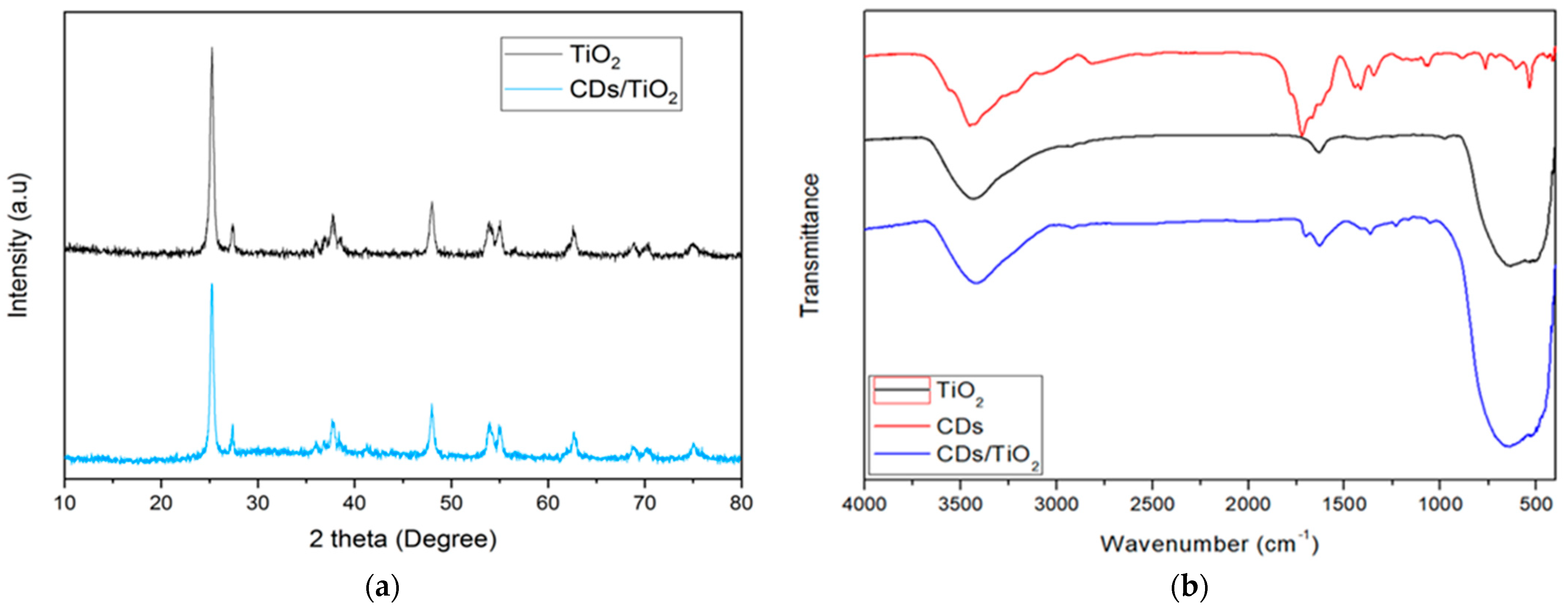
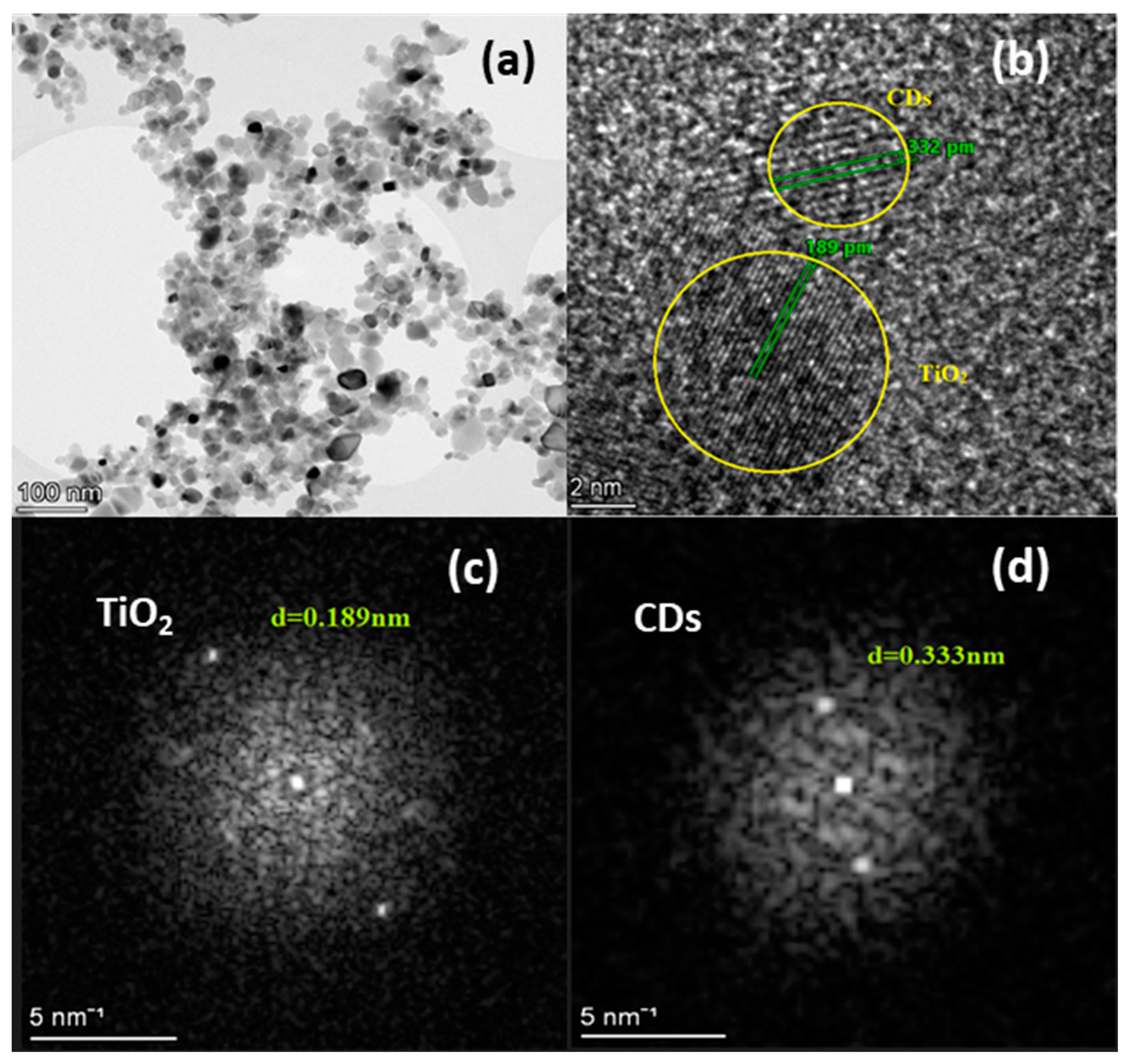
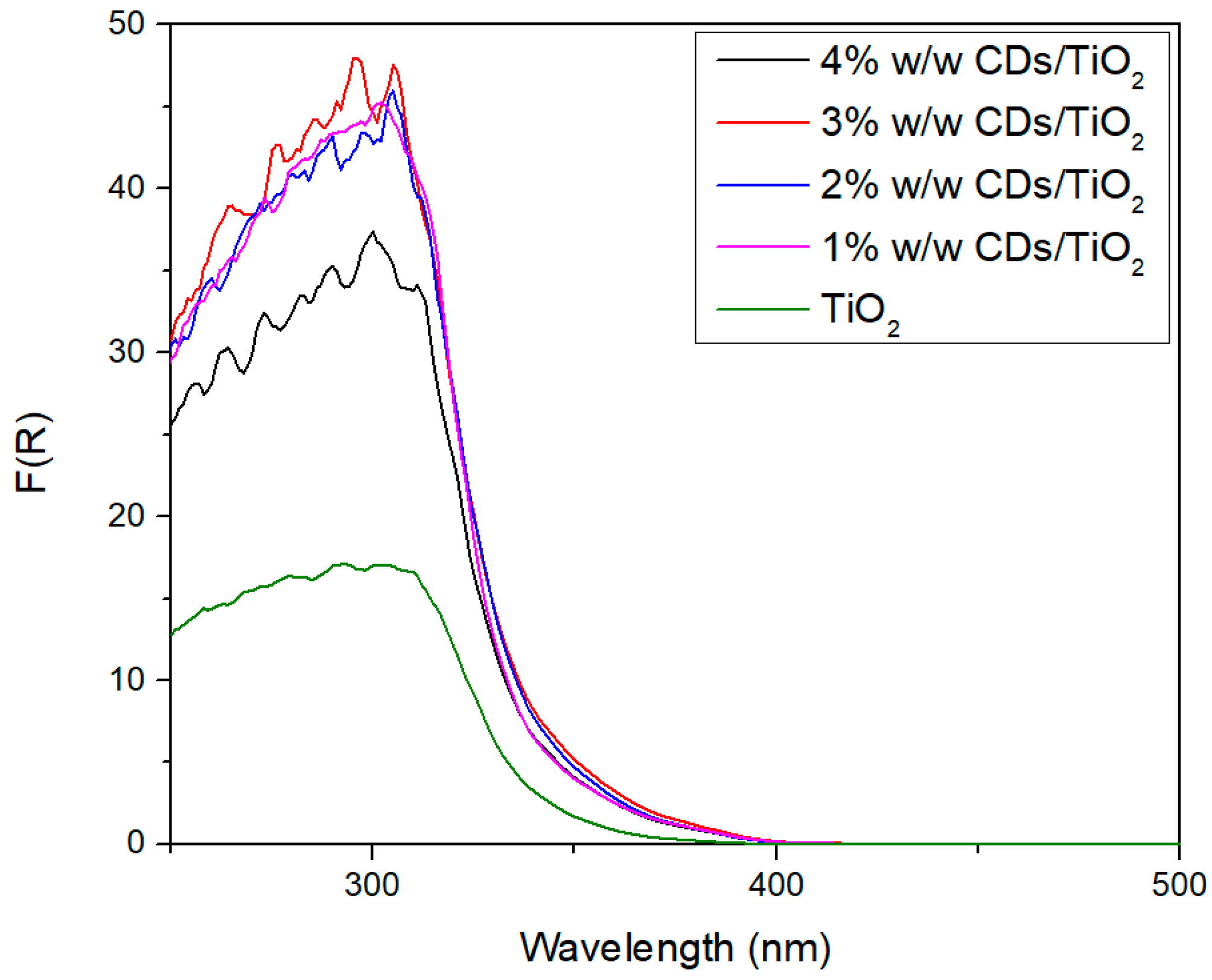
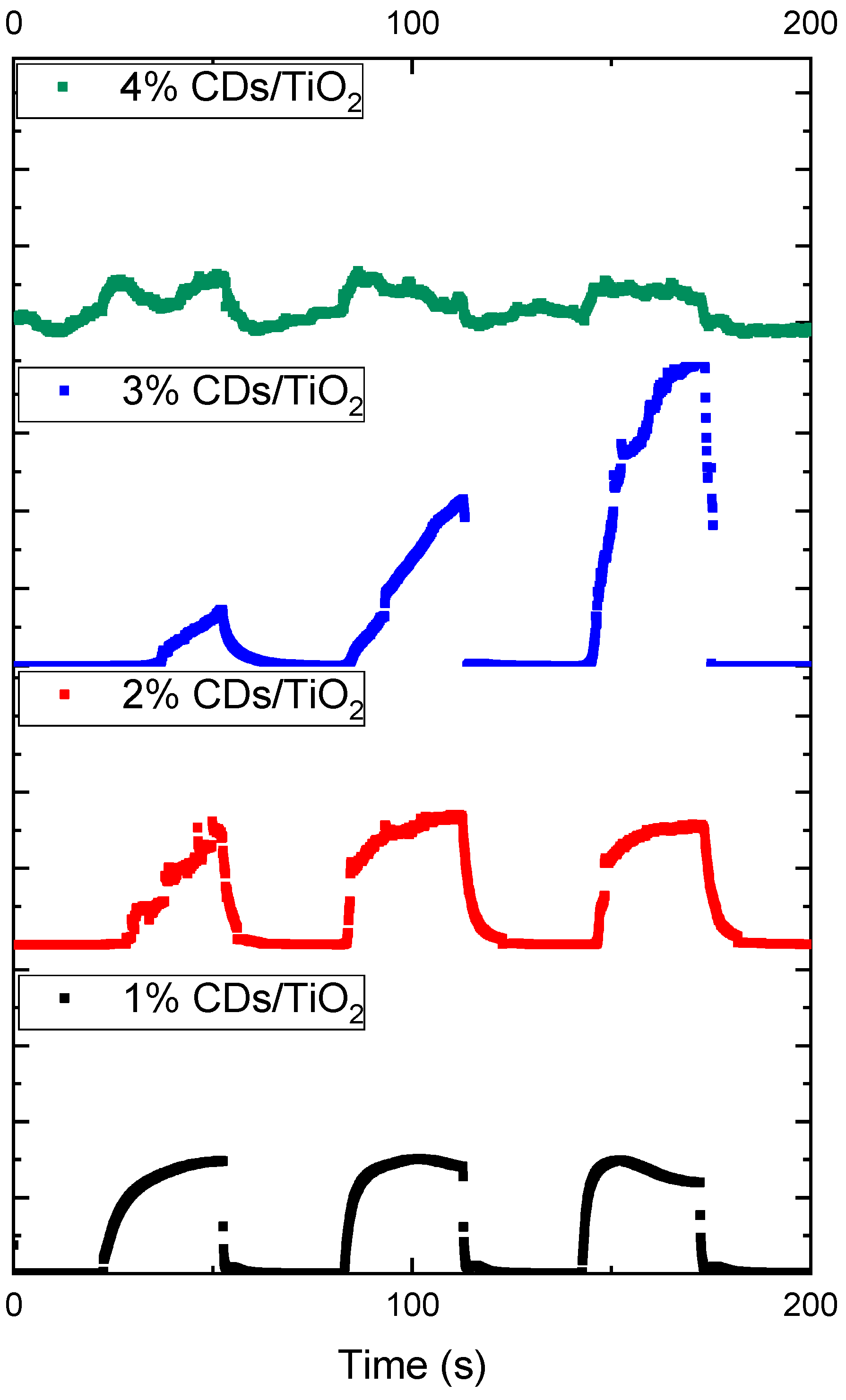
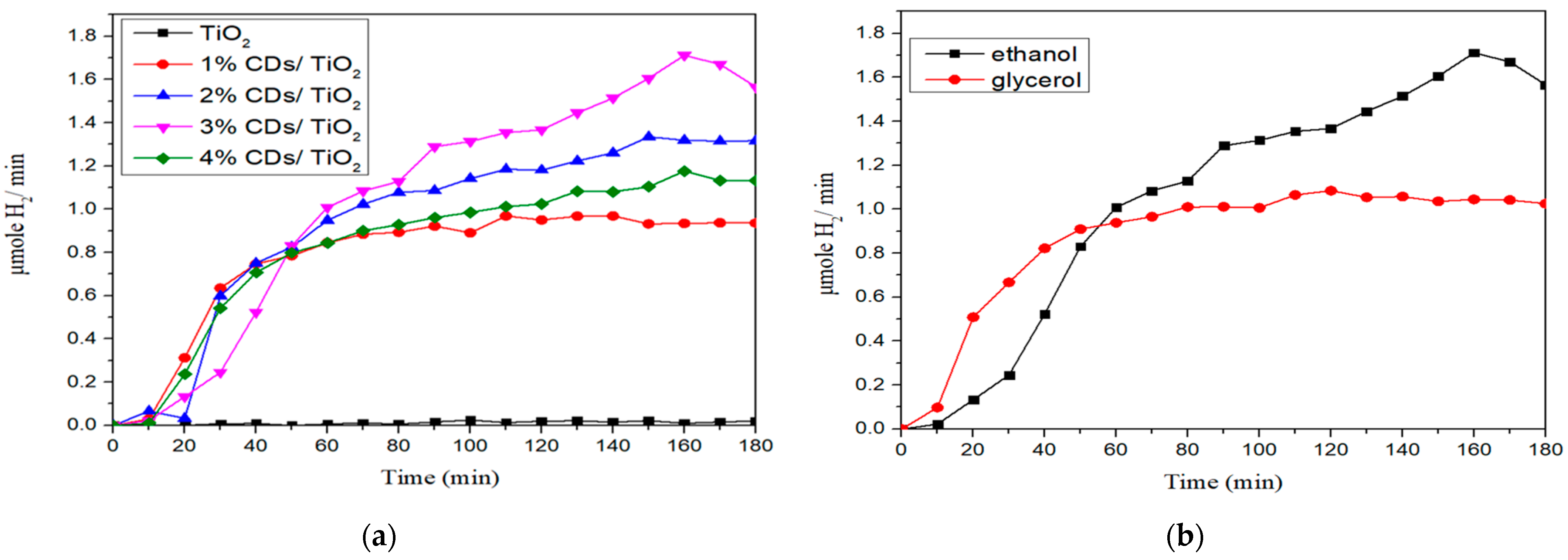
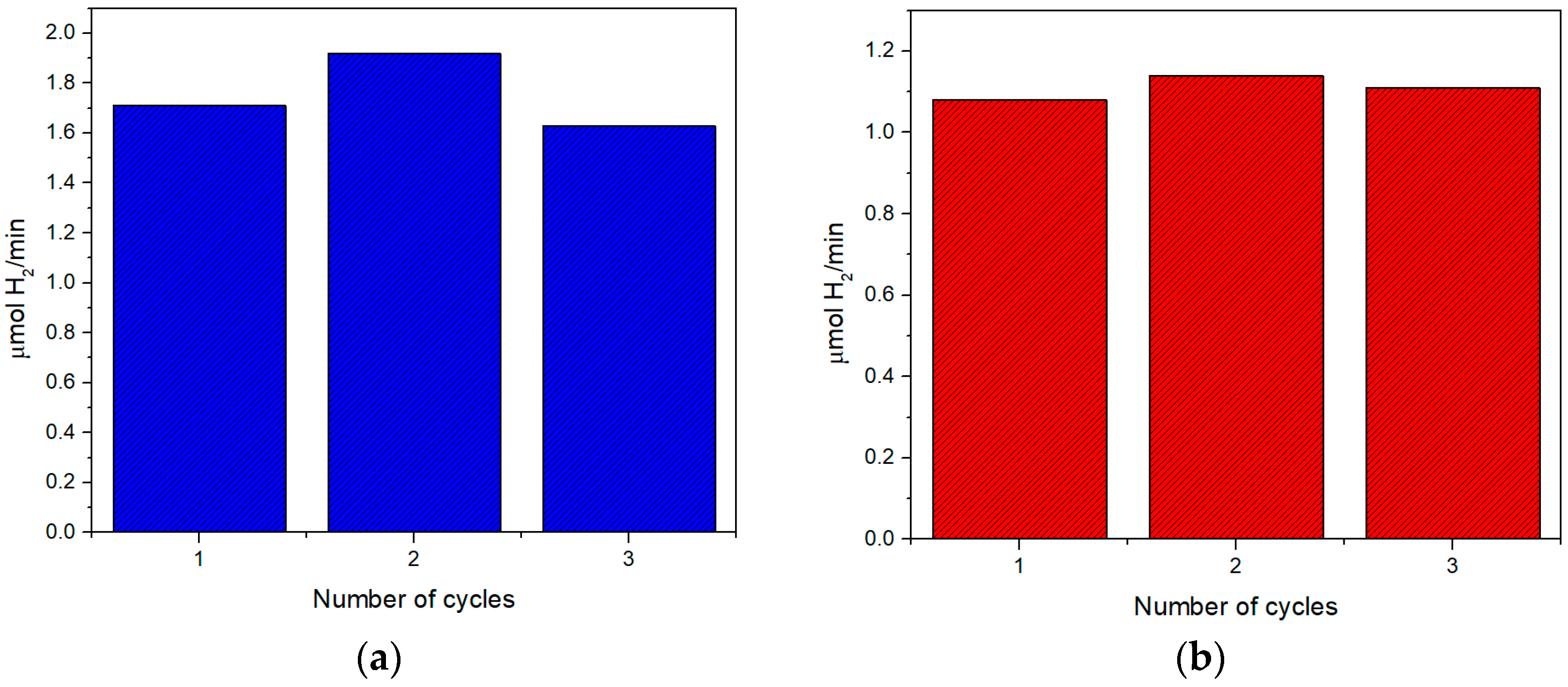
| Catalyst | Cocatalyst | Sacrificial Agent | Maximum Hydrogen Production Rate | Ref. |
|---|---|---|---|---|
| CD/TiO2 | - | 25% v/v ethanol | 1.7 μmol/min 102 μmol/h | This work |
| or | ||||
| 510 μmol/(h∙g) | ||||
| - | 25% v/v methanol | 9.8 μmol/h | [53] | |
| - | 0.3 M triethanolamine | 472 μmol/(h∙g) | [54] | |
| Pt | 1458 μmol/(h∙g) | |||
| CD/g-C3N4/TiO2 | Pt | 10% v/v triethanolamine | 580 μmol/(h∙g) | [55] |
| g-C3N4/TiO2 | - | 20% v/v methanol | 110 μmol/(h∙g) | [56] |
| Black phosphorus quantum dot/TiO2 | - | 20% v/v methanol | 112 μmol/(h∙g) | [57] |
| MoSe2/TiO2 | - | 30% v/v methanol | 401 μmol/(h∙g) | [58] |
| Red phosphorus/TiO2 | Pt | - | 215.5 μmol/(h∙g) | [59] |
Disclaimer/Publisher’s Note: The statements, opinions and data contained in all publications are solely those of the individual author(s) and contributor(s) and not of MDPI and/or the editor(s). MDPI and/or the editor(s) disclaim responsibility for any injury to people or property resulting from any ideas, methods, instructions or products referred to in the content. |
© 2024 by the authors. Licensee MDPI, Basel, Switzerland. This article is an open access article distributed under the terms and conditions of the Creative Commons Attribution (CC BY) license (https://creativecommons.org/licenses/by/4.0/).
Share and Cite
Falara, P.P.; Antoniadou, M.; Zourou, A.; Sakellis, E.; Kordatos, K.V. Carbon Dot-Titanium Dioxide (CD/TiO2) Nanocomposites: Reusable Photocatalyst for Sustainable H2 Production via Photoreforming of Green Organic Compounds. Coatings 2024, 14, 131. https://doi.org/10.3390/coatings14010131
Falara PP, Antoniadou M, Zourou A, Sakellis E, Kordatos KV. Carbon Dot-Titanium Dioxide (CD/TiO2) Nanocomposites: Reusable Photocatalyst for Sustainable H2 Production via Photoreforming of Green Organic Compounds. Coatings. 2024; 14(1):131. https://doi.org/10.3390/coatings14010131
Chicago/Turabian StyleFalara, Pinelopi P., Maria Antoniadou, Adamantia Zourou, Elias Sakellis, and Konstantinos V. Kordatos. 2024. "Carbon Dot-Titanium Dioxide (CD/TiO2) Nanocomposites: Reusable Photocatalyst for Sustainable H2 Production via Photoreforming of Green Organic Compounds" Coatings 14, no. 1: 131. https://doi.org/10.3390/coatings14010131
APA StyleFalara, P. P., Antoniadou, M., Zourou, A., Sakellis, E., & Kordatos, K. V. (2024). Carbon Dot-Titanium Dioxide (CD/TiO2) Nanocomposites: Reusable Photocatalyst for Sustainable H2 Production via Photoreforming of Green Organic Compounds. Coatings, 14(1), 131. https://doi.org/10.3390/coatings14010131








